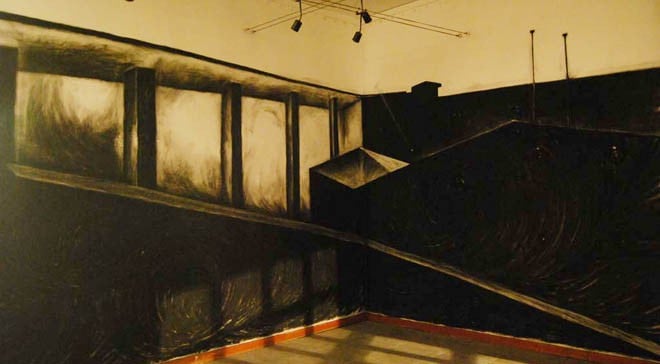

Even before you step into a show, you start imagining and anticipating the artworks, the gallery space, the light arrangement and, of course, the wealthy buyers. None of that happened on Jan 6, 2014, the opening night of Julius John’s solo exhibition at the Rohtas 2 in Lahore.
It was a different kind of experience, something that can be collected and retained in memory, though not in a tangible form.
John’s installation on display does not have any art objects, except two bathtubs and a plastic Christmas tree. A major part of the show comprises huge black crayon drawings executed on the gallery’s walls. These are images of houses, with details of structure, an ordinary metal chair and a plastic water tank on the roof, all rendered impressively. One of the bathtubs placed in the middle of the room is filled with black oil, while the one next to it is turned upside down with a pink plastic Christmas tree fixed on top of it.
All of these refer to the artist’s long association with urban scenes and issues, mainly from his familiar environment. His observation of how the city is turning into two separable halves, of privileged and slum areas, is evident in the way he maps the surroundings which belong to low income groups, which also happen to be an ethnic or religious minority.
The drawings on the wall are about the locality of small houses; the bathtub containing the black liquid is about a drain cutting through a populated neighbourhood. The insertion of the tree may be read as a tongue-in-cheek comment upon the condition of a community that celebrates its rituals, amid fears of religious extremism and in the face of extreme poverty.
Apart from these obvious readings which could be misleading -- since all obvious interpretations prove to be deceptive -- the work suggests something different too. In a way, John’s work is more about the visual experience related to art and art circles. Interestingly, the drawings of houses are an attempt to bring the real world into the realm of art. These could be part of an attempt to subvert the exclusive sphere of art and convert the sacredness of gallery into a banal and usual setting.
The site-specific installation serves to blend the gallery interior with transitory imagery; the architecture of gallery is connected with the layout of buildings drawn and is enhanced by the play of light, since the shadows cast on empty walls seem to complete the ambience of an ordinary area.
The choice of material -- black crayon -- increases the effect of shadows. At some point, one starts getting the feeling of being in the area -- away from the physical location of the gallery, experiencing the streets with open drains, exposed electricity wires and depilated houses.
Another shock which takes one away from one’s safe viewing position is to find no works on ‘display’. Despite the fact that the walls are covered with images, there are no ‘normal’ artworks which can be hung or dismantled or stored after being purchased.
This aspect of Julius John’s art is a comment on the growing art market which transforms and reduces an artist’s creative output into a commodity. He defies this notion of product and the procedure of selling and purchasing art which, for many individuals, has become the sole purpose for making art. On the contrary, the purpose of an exhibition is sharing of an experience.
More than any other thing, the two bathtubs as symbols of dirty sewerage are a comment on the situation of Christians in this country. For multiple reasons, the concept of dirt and cleaning has been associated with this religious minority, which renders it almost untouchable for the Muslim majority. The bathtub levelled with tar like substance, signifying the city’s ganda naala, as explained by the curator Seher Tareen, denotes the task or fate of local Christian community as cleaners. While the upside bathtub with the plastic tree appears like a grave and reminds the vulnerable position of this community in a Muslim dominant population.
The carnage of Joseph Colony and the killings at the Peshawar Church are a just a few recent reminders.
There can be several formal reasons for the artist’s decision to use only black but when compared with the imagery, that is mainly of dusk and the quote from the bible on the invitation card "… and darkness came over the whole land until three in the afternoon, for the sun stopped shining. (Luke 23:44,45)", one empathises with the reason behind the various layers of darkness. The darkness may refer to the forces of bigotry that are spreading and gaining power in our surroundings.
In a sense, the murkiness at the gallery has nothing to do with the situation of the poor nor is it only about a religious community but it is the state of the larger majority which has descended into this darkness at noon without a way out.
The show will continue till Jan 15, 2013, at Rohtas 2 in collaboration with P.S. ART and Faiz Foundation Trust.